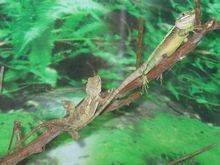Subphylum Vertebrata | Phylum Chordata Class Reptilia Suborder Iguania Rank Species | |
 | ||
Similar Calotes nemoricola, Calotes ellioti, Japalura brevipes, Calotes grandisquamis, Phrynocephalus versicolor | ||
Calotes jerdoni, commonly known as the Indo-Chinese forest lizard, is a species of agamid lizard endemic to China and South Asia.
Contents
Etymology
The specific name, jerdoni, is in honor of British biologist Thomas C. Jerdon.
Description/Identification
Physical Structure: A compressed bodied lizard. This species resembles Calotes maria in pholidostic and other characters except that 45-57 scales round the body; gular scales much larger than the ventral scales; there is an oblique curved fold covered with small granular scales in front of the shoulders; nuchal crest less prominent; the hind-limb reaches to the eye or not quite so far. Dorsal and lateral scales directed upward.
Color Pattern: Deep-green dorsal coloration with yellow, orange or brown spots, but in many cases can make the body into a dark brown within a few seconds.
Length: Maximum: 38.5 cm, Common: 32 cm. (Snout to vent 9 cm.).
Maximum published weight: ? g.
Distribution
Bangladesh, Bhutan, China (W Yunnan, Xizang = Tibet), India (Khasi Hills in Assam & Shillong) and Myanmar.
Vernacular names
Bengali: সবুজ গিরিগিটি (Sabuj girigiti), সবুজ রক্তচোষা।
Bhutanese: ?
Burmese: ?
Chinese: ?
English: Green forest lizard, Green garden lizard, Indo-Chinese forest lizard and Jerdon's forest lizard.
Hindi & Assamese: ?
Habit & Habitat
Terrestrial & arboreal; diurnal; found in many types of forested land. prefers dense and bushy hill forest. A skilful and an adept climber, it moves over trees and bushes rather swiftly. It is active during the day time.
Diet
Insectivorous; feeds largely on insects but at times bird-eggs, nestlings, and frogs too are eaten up.
Reproduction
Oviparous; breeding season begins around April when males develop bright coloration in the forebody and begin to chase females. Female digs a small hollow in soft earth and lays 11-23 eggs in it for incubation and safety.
Uses
No known practical uses. Play rolls in ecosystem by eating various types of insects and otherwise.
Threat to humans
Non-venomous and completely harmless to humans.
IUCN threat status
Not Evaluated (NE).
